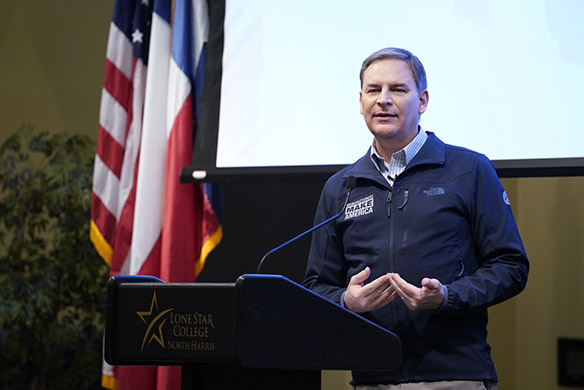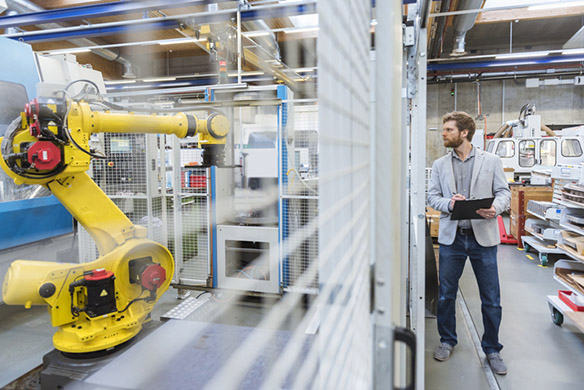 |
| If you’re having trouble reading this, click here. |
 |
| INPUT |
 |
|
|
 |
| Top Takes on Manufacturing, Politics and Policy |
 |
By Rachel Hostyk – February 21, 2019– SHARE


|
 |
| Presented by Salesforce
|
 |
 |
|
Good Thursday morning! Today takes the State of Manufacturing Tour to Sheffield and Cedar Rapids, Iowa, where it will visit Sukup Manufacturing Company, Kirkwood Community College and Johnson County Regional Center at the University of Iowa. For more information, go to CreatorsWanted.org.
Top Headlines
|
|
The State of Manufacturing |
 |
 |
Yesterday, before an audience of more than 300 students, school administrators, faculty and area manufacturing and business leaders, NAM President and CEO Jay Timmons delivered his State of Manufacturing Address at Lone Star College in Texas. You can watch the full address here or read it here.
He spoke about the future of manufacturing—its need for more young “creators” to join it, and better training to equip them for technological transformations in their work. He also covered the major issues concerning manufacturers today.
First, infrastructure:
- “We need modernized ports, waterways, pipes, pipelines, electric grid and airports—as well as next-generation communications infrastructure like 5G technology.”
- “So, manufacturers are calling on Congress to make a serious investment in our nation’s infrastructure. Without action, we will lose 5.8 million jobs by 2040. But with an injection of $1 trillion in American infrastructure, we will create 11 million.”
Then, trade:
- “Number one: manufacturers are counting on Congress to ratify the U.S.–Mexico–Canada Agreement and to do so quickly. These two countries are our most important trading partners.”
- “Second, we want to see the administration come to an agreement to hold China accountable.”
And last, immigration:
- “The broken system is not fair—not to the Dreamers who know no home other than the United States of America; not to Americans who want to know their country is secure.”
- “Manufacturers understand that a truly comprehensive solution has to show compassion, provide security and address economic realities. Last week, the NAM released just such a plan. We sent it to Congress. And we sent it to the White House.”
- “It’s not all Republican ideas. It’s not all Democratic ideas. It’s a realistic compromise. That’s what it’s going to take. And that’s what Americans expect.”
|
|
 |
| This publication is a first look at breaking news, not the last word on anything. For the Official NAM Position on any given policy, please contact the staff leadership.
|
 |
|
Fuel Talks Sputter |
 |
 |
The U.S. government has ended negotiations with California over a possible agreement about vehicle emissions and fuel economy standards, reports Reuters. A little background:
- “California and 19 other states have demanded the Trump administration abandon a proposal made in August to freeze fuel efficiency standards after 2020 and strip California of the ability to impose stricter rules.”
- “The California Air Resources Board (CARB), California’s top clean air regulator, has been meeting with officials from the White House, U.S. Environmental Protection Agency and Transportation Department over Trump administration efforts to stop California from tightening vehicle emissions rules in the state.”
There’s some confusion about the way forward:
- “The government official offered no further details on the end of the talks and it was not immediately clear when an announcement would be made.”
- “California officials already have filed suit to block the Trump administration proposal to roll back federal fuel economy targets for 2022-2025. It is not clear how the industry would respond to the formal adoption of Trump’s proposed freeze, and likely litigation by California and other states.”
This news will trouble automakers, who have urged both the federal agencies and California to compromise and produce uniform rules for the entire country. NAM Vice President of Energy and Resources Policy Ross Eisenberg stopped by to comment on this development:
-
“Manufacturers need one national standard for fuel economy and GHG emissions that results in year-over-year improvements. While an agreement by all three agencies would have been preferable, it is not the only way to achieve the certainty manufacturers need. The NAM will continue to work toward a solution that provides a ‘win’ for the environment and the economy.”
|
|
America’s 5G Lead |
 |
 |
The United States is adopting 5G networks faster than its competitors, according to a new report from Cisco. The Washington Post (subscription) sums up the findings, which could help reassure those worried about China’s progress in this area:
- “‘By 2022, fifth-generation cellular networks will power as many as 9 percent of mobile data connections across North America, Cisco said, compared with 4 percent in Asia. The new projections were unveiled Tuesday as part of Cisco’s annual Visual Networking Index report, which studies industry trends.”
- “The report underscores the substantial work that countries like China face as they seek to out-develop Western nations. And it reflects U.S. policies that put the United States in a strong position to lead, said Cisco, which makes networking technology.”
- “Although the Asia-Pacific region will be home to more than twice the number of 5G devices than North America by 2022, 5G connections will account for a tiny share of the mobile devices in that region, according to Cisco. 5G connections will account for a greater share of mobile devices in Western Europe, about 6.5 percent.”
This is good news, but the NAM believes the United States can do better and go faster. It’s working for even more policy advancements to support the adoption of this essential technology. |
|
 |
| A Message from Salesforce |
 |
 |
 |
Becoming Customer-Centric
With connected devices, manufacturers can personalize the customer experience. Learn how Jacuzzi is using technology to focus on providing the most intelligent customer experience. |
|
Automation Abroad |
 |
 |
American manufacturers can learn from what goes on in other countries, as many trends facing the industry here—such as advancements in automation and artificial intelligence (AI)—are actually taking place across the industrialized world.
For example, Asia is facing its own version of the “skills gap”—a Microsoft study found that many companies can’t find enough skilled workers to implement AI technologies. Meanwhile, a recent study in the Netherlands looked at how the increase in automation affects workers. The Harvard Business Review (subscription) reviews the results:
- “Surprisingly, this burden [of automation] falls more frequently on highly-educated and highly-paid workers. Contrary to conventional wisdom, they are more likely to leave as a result of automation, although they also seem to find new jobs faster. In other words, highly-paid workers are more commonly affected, but the effects are more severe for less well-paid workers.”
The study also found that automation isn’t as disruptive as many people fear (at least in the Netherlands):
- “The data shows that workers do experience loss of both earnings and work following a spike [in automation adoption], but that these losses are substantially less than that experienced by workers following a mass layoff. In the sample, only 0.7% of all workers on average leave their employers each year due to automation.”
- “In contrast, in the Netherlands, about 3.5%-7.2% lose their jobs each year in mass layoffs, typically defined as a layoff of 30% or more of the workforce. (The comparable rate is 4.4% in the U.S.) The risk of anyone losing a job due to automation is thus much smaller than the risk of a mass layoff.”
As the study points out, layoffs are sweeping and sudden, whereas automation is adopted gradually, allowing workers more time to prepare and adapt.
The Manufacturing Institute has long stressed that automation usually complements human labor, and while it takes away some duties or jobs, it also creates others. The finding that automation doesn’t cause huge disruptions reinforces that argument (though one study is hardly determinative).
However, the United States desperately needs the educational programming that will prepare workers for a fast-changing future. Indeed, that’s why the Institute and the NAM are on the NAM State of Manufacturing Tour this month speaking to so many businesses, students, politicians and community leaders. |
 |
| Industry Headlines |
 |
|
|
 |
| NAM News |
 |
- More State of Manufacturing Tour coverage: Read an op-ed by NAM President and CEO Jay Timmons and Sukup Manufacturing Company President Charles Sukup in the Des Moines Register, plus another op-ed by Timmons in the Houston Chronicle (subscription). Then read the Washington Examiner’s coverage of Timmons’s State of Manufacturing Address, which as I wrote yesterday was previewed in Axios and in Politico Playbook.
- Senator Rob Portman (R-Ohio) took part in the tour yesterday. Read a press release from his office.
- Several Politico newsletters (all subscription only) highlighted elements of Timmons’s State of Manufacturing Address: Morning Trade, Morning Shift, Morning Transportation, and Morning Energy.
|
 |
|
If you’re part of an NAM member company and not yet subscribed, email us. If you’re not an NAM member, become a member today.
|
|
|
|
 |
|
|
|
 |
|
|